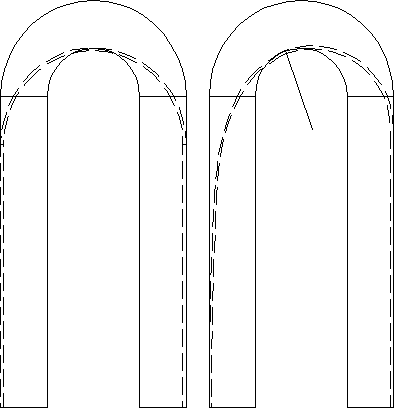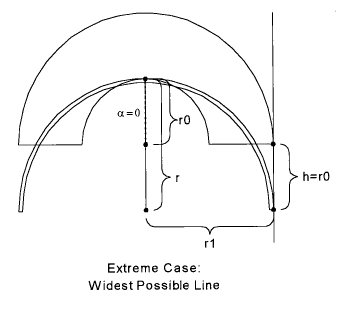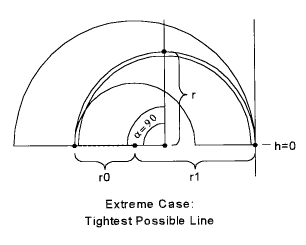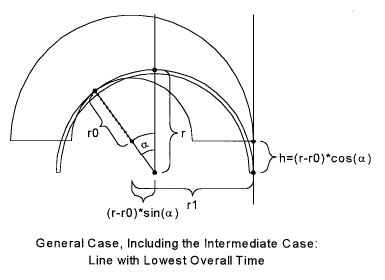
|
 |
|
"Slow-in, Fast-out!" or, Advanced Analysis of the Racing Line by Brian Beckman PhD
You may remember way back in Introduction to the Racing Line that we did some
simple calculations by hand to show that the classic racing line through a 90-degree right-hander is better than the either the line that
hugs the inside or the line that hugs the outside of the corner. 'Better' means 'has lowest time.' The 'classic racing line' was, under the
assumptions of that article, the widest possible inscribed line.
In this and the next instalment of The Physics of Racing, we raise the bar. Not only do we calculate the times for all lines through a corner, but we show a new kind of analysis for the exit, accounting for simultaneously accelerating and unwinding the steering wheel after the apex. This kind of analysis requires us to search for the lowest time because we cannot calculate it directly. We apply the approximation of the traction circle to stay within the capabilities of the car. We also model a more complex segment than in Introduction to the Racing Line, including an all-important exit chute where we take advantage of improved corner-exit speed. This style of analysis applies directly to computer simulation that we now have in progress in other continuing threads of The Physics of Racing. The whole point of this analysis is to back up the old mantra: "slow-in, fast-out." We will find that the quickest way through the whole segment does not include the fastest line around the corner. Rather, we get the lowest overall time by cornering more slowly so we can get back on the gas earlier. It's always tempting to corner a little faster, but it frequently does not pay off in the context of the rest of the track. This analysis is sufficiently long that it will take two instalments of this series. In this, the first instalment, we do exact calculations on a dummy line, which is the actual line we will drive up to the apex, but just a reference line after the apex. In the next instalment, we improve on the dummy line by accelerating and unwinding, predicting the times for a line we would actually drive, but entailing some small inexactitude. Let's first describe the track segment. Imagine an entry straight of 650 feet, connected to a 180-degree left-hander with outer radius 200 feet and inner radius 100 feet, connected to an exit chute of 650 feet. In the following sketch, we show the segment twice with different lines. The line on the left contains the widest possible inscribed cornering radius, and therefore the greatest possible cornering speed. The sketch on the right shows the line with the lowest overall time. Although its cornering speed is slower than in the line on the left, it includes a lengthy acceleration and unwinding phase on exit that more than makes up for it.  Line with Fastest Cornering Speed Line with Lowest Overall Time Note that both lines begin on the extreme right-hand side of the entry straight. Such will be a feature of every corner we analyse. Lines that begin elsewhere across the entry straight may be valid in scenarios like passing. However, we focus here on lines that are more obvious candidates for lowest times. Also, throughout, we ignore the width of the car, working with the 'bicycle line'. If we were including the width, w, of the car, we would get the same final results on a track with outer radius of 200 + w / 2 feet and inner radius of 100 - w / 2 feet. First, we compute exact times where we can on the course: the entry straight, the braking zone, and the corner up to the apex. To have a concrete baseline for comparison, we also do a 'suboptimal' exit computation-the dummy line-that includes completing the corner without unwinding and then running down the exit chute dead straight somewhere in the middle of the track. In the next instalment of The Physics of Racing, we compare the dummy line to the more sophisticated exit that includes simultaneously accelerating and unwinding to use up the entire width of the track in the exit chute. Let us enter the segment in the right-hand chute at 100 mph = 146.667 fps (feet per second). We want the total times for a number of different cornering radii between two extremes. The largest extreme is a radius of 200 feet, which is the same as the radius of the outer margin of the track. It should be obvious that it is not possible to drive a circle with a radius greater than 200 feet and still stay on the track. This extreme is depicted in the following sketch: 


With these data, we're now equipped to compute all the times up to the apex
and beyond. First, let's compute the speed in the corner by assuming that our
car can corner at 1g = 32.1 ft / s2
= v2 / r,
giving us Now that we have the maximum cornering speed, we can compute how much braking
distance we need to get down to that speed from 100 mph. Let's assume that our
car can brake at 1g also. We know that braking causes us to lose a little
velocity for each little increment of time. Precisely, dv / dt = g.
However, we need to understand how the velocity changes with distance, not with
time. Recall that dx / dt = v,
dt = dx / v, so we get dx = vdv / g.
Those who remember differential and integral calculus will immediately see that
We next subtract the braking distance from the entry straight, and also subtract h, to give us the distance in which we can go at 100 mph, top speed, before the braking zone. Now, we need the time spent braking, and that's easy:
At first glance, it appears that the widest line is a huge winner, but
we must realize that these times include only driving up to the apex, and that
is far earlier on the widest line, where
So, we see that, driving the dummy line, the widest line yields the slowest time from the entrance up through the complete semicircle, but the quickest overall time when the exit chute is included. The widest line has lower (better) times than the tightest line in
The widest line has higher (worse) times by about a second in the circle itself because the wider circle is also longer. When the balances are all added up, the widest line is about eight tenths quicker than the tightest line, but it's all because of the effects of the corner on the straights before and after. Recall once again that the dummy line is not a line we would actually drive
after the apex. But, with that as a framework, we're in position to introduce
the next improvement. Everything we do from here on improves just the post-apex
portion of the corner and the exit chute. We will actually drive the dummy line
up to the apex. So, from this point on, we need only look at the last column in
the table above, where we are shocked to see that there are almost three
seconds' spread from the slowest to the quickest way out. A good deal of this
ought to be available for improvement by accelerating and unwinding.
|
| Contact Sim-Racing : info (at) sim-racing.co.uk |
Sim-Racing.co.uk © 2012 - 2025 Zouq.co.uk |
 |